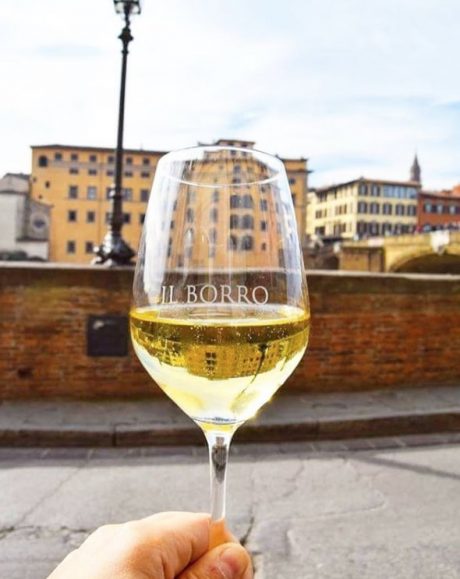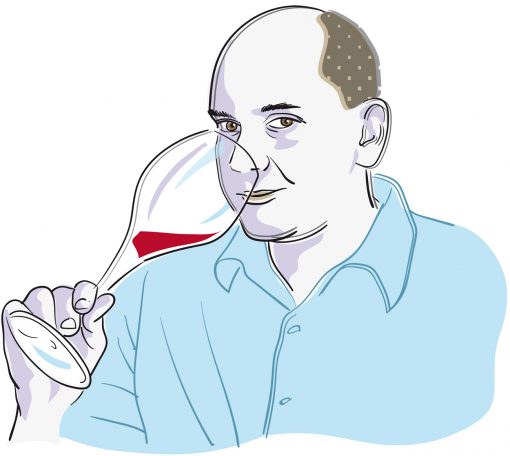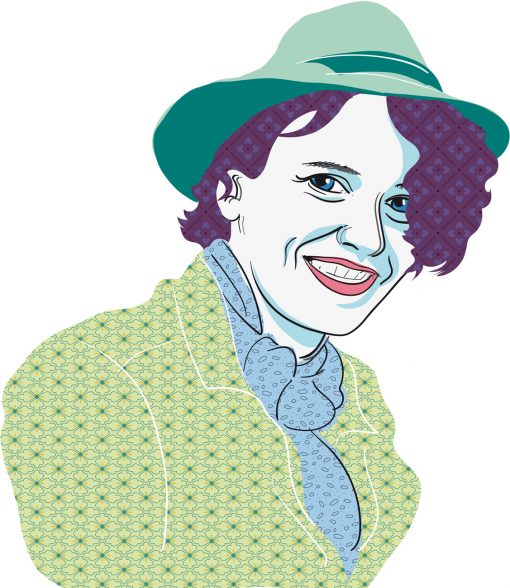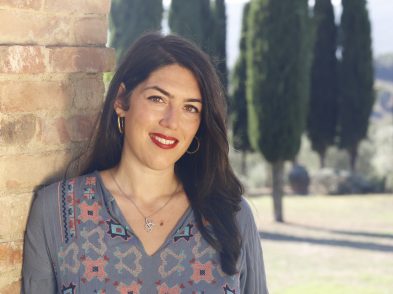If you want to know anything about wine, ask a sommelier. These wine lovers put their livers on the line every day to bring the very best labels to your glasses. I spoke to six of Florence’s top wine waiters about their “madeleine” moment, house party picks and insider information for this year’s releases.
Ph. via @tuscanbistro, Instagram
“Don’t forget rosé, which has been garnering more and more success in recent years”
-Salvatore Biscotti, Borgo San Jacopo
All illustrations by Leo Cardini
What’s your earliest memory of wine?
My first approach to the wine world was here in Florence. To pay for my studies I got a job working at the restaurant Alle Murate. I came to Florence to study forestry science and what was supposed to be a side thing instead became my passion and my profession.
What brought you into the wine world?
I’m lucky to have had mentors. The owner of Alle Murate and the sommelier Sonia Cavigli sparked my curiosity and made me realise how selling wine could be a way for me to specialize in the restaurant world. Later, it also became a way to meet new people and make lots of friends.
The bottle you’d take to a house party?
Champagne. Perhaps a simple, not a vintage one. In my work I see how happy Champagne always makes everyone.
The bottle in your cellar you’re aching to open?
At home I’d open a bottle among friends or for a quiet dinner. I have a personal cellar that I’ve developed over the years, visiting producers, buying wine on my travels and organizing group purchases with wine lovers like me. When I go down into my cantina, I take my time and the choice always comes after a while. At the restaurant, I’d opt for a great Burgundy, red or white.
The most popular wine ordered by Americans? Other nationality-related quirks?
The wine that Americans order the most is Brunello, as it’s the best-known appellation in the States, but they are happy to embrace suggestions about the winery. Asians prefer wines with a high sugar residue or to drink a Moscato d’Asti with a meal. Russians love fuller-bodied wines and classic Super Tuscans made from international varietals. Brits and English speakers choose Amarones and Barolos, but won’t turn up their noses at an elegant Tuscan Sangiovese.
What advice would you give to someone wanting to learn more about wine?
My advice to those wanting to learn is twofold. Firstly, get some training, choosing a course that leads you into the wine world. But don’t stop there: act independently, visiting wineries, attending tastings that are open to the public, be curious and follow recommendations given in restaurants and wine bars.
Your top wine tip for 2018?
My recommendations for a top wine in 2018 fall into two categories: Tuscan Sangiovese in its most diverse expressions, from Brunello di Montalcino to Chianti Classico, IGT or Super Tuscans, with elegance as the common denominator across the region. And don’t forget rosé, which has been garnering more and more success in recent years.
“Taste lots of different wines to find out about the area where they are produced”
-Bianca Ciatti, La Divina Enoteca
What’s your earliest memory of wine?
It’s always a pleasure to think back to my first sommelier lesson organized by FISAR. It was all so new: the wine, glasses, aromas and flavours. Up until then I’d never drank wine, but I wanted to learn as much as possible so that I could open my enoteca with Livio {Livio Del Chiaro, co-owner of La Divina Enoteca and FISAR Italian Sommelier of the Year in 2004}. Over time I’ve become an enthusiast. I started to taste, study and travel to find out about new wineries and new tastes to the point that I now teach future sommeliers.
What brought you into the wine world?
As I mentioned, I’ve never really been a drinker but in 2008 I took that sommelier course so that I’d be able to choose the wines I’d be selling as well as learning how to recognise a good wine from a faulty one and knowing how to pick the best food pairing according to the customer’s tastes and needs.
The bottle you’d take to a house party?
You can never go wrong with taking Champagne to a party! Staying in Italy, I’d also take some bubbles, perhaps a Verdicchio Spumante Metodo Classico. If I were to choose a red, I’d opt for a Tuscan Syrah: it’s a wine that most people will like, even non-wine experts.
The bottle in your cellar you’re aching to open?
I have a few Montevertine’s Le Pergole Torte vintages in my cellar and the 2010 is almost ready to open.
The most popular wine ordered by Americans? Other nationality-related quirks?
Americans mainly ask for Prosecco as an aperitif or a full-bodied red, preferably a Super Tuscan but also Vino Nobile di Montepulciano, Chianti Classico and Brunello di Montalcino. When I explain them to our customers, I have to say that orange wines go down really well, as do amphora-aged wines. Our French clients enjoy rosés, while the Brits plumb for Prosecco and dry whites and Germans love Vermentino. Brazilians want Barolo, our Chinese customers seek out old vintages of top reds and the Japanese love trying new things, especially sparkling rosés and Sangiovese-based wines. The Spanish ask for ice-cold beer. Chianti Classico is the most popular wine we sell to foreigners.
What advice would you give to someone wanting to learn more about wine?
Taste lots of different wines to find out about the area where they are produced. Always drink responsibly of course—there are plenty of tasting events in and around Florence where you can talk with the producers. And take a sommelier course obviously!
Your top wine tip for 2018?
I’d recommend the outstanding Brunello di Montalcino Riserva 2012 from Lisini for a special occasion.
“My advice is to be bold enough to “play” with your wine”
-Anna Paclet, Ora d’Aria
What’s your earliest memory of wine?
I was about eight; it was New Year’s Eve. My parents and I had been invited to our friend’s house in the hills of Chianti. The adults were toasting with Champagne and the children with Sprite, and somehow I got a glass of Champagne instead! I still remember the taste of that very first sip, the surprise and the excitement. The strange coincidence is that today my friend is also working with wine, making a beautiful Chianti Classico (Torcibrencoli) from the vines around that house.
What brought you into the wine world?
It may sound crazy but my interest in the wine world began while I was living in Singapore and working as the manager of an Italian restaurant there. One of my colleagues who was Chinese was studying to become a sommelier and shared that passion with me.
The bottle you’d take to a house party?
Mira – Porta del Vento. A Sicilian 100% Catarratto, Champagne method. Fun, unexpected and crispy with a marvelous chestnut scent.
The bottle in your cellar you’re aching to open?
Montagne-Saint Emilion 1966 (Chateau des Tours, Bordeaux).
The most popular wine ordered by Americans? Other nationality-related quirks?
I don’t like to generalize because with my kind of job you never really know who is sitting in front of you, and no matter where they come from you can always learn a lot from your customers. Let’s say that as a first approach Americans tend to like full-bodied wines, velvety and rounded with oaky vanilla notes, Bolgheri style, but as soon as they get into the rough and wild Tuscan mood they start to appreciate more complex and sophisticated Sangiovese-based wines such as Brunello di Montalcino. Asians generally start their approach with sweet off-dry sparkling wines such as Moscato d’Asti or Prosecco, as well as aromatic (or semi-aromatic) whites like Riesling, Gewürztraminer or Sauvignon Blanc. In terms of red wines, mellow and rich Amarones have always enjoyed great success.
What advice would you give to someone wanting to learn more about wine?
Be bold enough to “play” with your wine. Once you’ve opened the bottle try to learn how the wine changes and develops. If it’s white, serve it very chilled, then take it out of the bucket and see how the aromas and the flavors change as the temperature rises. Sometimes you’ll be surprised to find that some white wines give their best at higher temperatures. For reds, it’s the same story but the other way round. Try them at a lower temperature, remembering that even the most complex and aged red doesn’t need to be served at more than 18°C! Another tip is not to drink the bottle the same day. Try it the day after, or even a week after, and see what happens with some oxygen as it can develop very interesting tastes. Experiment with food pairing and see how the wine changes when accompanied with certain foods. Remember that rules are made to be broken. In the worst case scenario, your wine won’t taste good, but sometimes magic happens and you fall in love.
Your top wine tip for 2018?
Go off the beaten path. Look for wines from small producers who are working in a sustainable way, respecting the pace of nature and the vine. If you’ve never heard about them before it’s a great sign. We tend to feel comfortable choosing labels we already know, but it’s not always the best solution.
“My first memory of wine is the flask bottle, the “fiasco””
-Andrea Gori, Trattoria da Burde
What’s your earliest memory of wine?
Like everyone in Italy, my first memory of wine is the flask bottle, the “fiasco”, at my parents’ table, but the first memory that struck me as an adult was a San Felice Vigorello 2001 during my sommelier studies, a Super Tuscan blend that was so fruity, intense and deep-layered that I never thought was possible for a Tuscan wine.
What brought you into the wine world?
My family own a trattoria since 1901, so in some ways you could say I was born into wine and food. The decision of starting a sommelier course changed my life, but it started as a strategy, a way for me to find my own personal space in my family’s restaurant since every other area of business was covered by my parents. It’s never easy to find your place in Italy in this kind of business and fine wine was my only free space since at Burde we were only used to selling vino della casa.
The bottle you’d take to a house party?
For a sure success with a red I’d choose a bottle of Bolgheri—fruit, soft tannins and intense aroma of red and black berries—or a bottle of Champagne as good bubbles never fail to impress! If I know that there’ll be some wine nerds, then a Tuscan Pinot Noir will make them happy!
The bottle in your cellar you’re aching to open?
Some 2010 Brunello and Barolo, but it’s really too soon for the best of them, so a wonderful bottle of Vintage Port bought for my son… It will take decades until it’s fully developed!
The most popular wine ordered by Americans? Other nationality-related quirks?
Americans that come by Burde (we’re not in the city centre) are not the typical tourists so they ask for Sangiovese, mainly Brunello but also some small crus from the Chianti Classico area and natural wine producers in lesser known areas. Chinese and Russians always go for top level labels like Tignanello, Solaia, Masseto and Lupicaia, and more recently also Tenuta di Biserno owned by Ludovico Antinori. German wine lovers also like some whites, including the beloved Vernaccia di San Gimignano.
What advice would you give to someone wanting to learn more about wine?
Try to take a brief wine course as soon as possible. The first level (14 lessons) by the various Italian sommelier associations are a good start, but there also WSET wine courses that are useful and shorter. It doesn’t matter.
Your top wine tip for 2018?
Brunello 2013 and Chianti Classico 2015 and 2016 will be available and are almost ready to drink with ease. Also look for the surprising old-style 2014 from the Langhe area (Barolo and Barbaresco). Going outside of Italy, 2008 Champagne is wonderful and rich. And even if it’s difficult to find them in Florence, top producers of Irpinia (Fiano, Greco and Taurasi) are really in their finest hour!
PLUS
TF’s two cents
“I love listening to producers, the most natural storytellers I’ve ever met”
-Helen Farrell, The Florentine
What’s your earliest memory of wine?
I fell in love with wine in Poggibonsi during my first summer in Tuscany. It was nothing special. A hard-hitting, tannin-crazy Sangiovese: your typical contadino wine. Black as ink, dark as the devil, intense like a tropical storm: before that first sip I was your average English girl with average English girl drinking habits. Pints of Foster’s at university, my wine knowledge extended no farther than the Gallo brothers’ Ruby Cabernet.
What brought you into the wine world?
Even though I write about wine for The Florentine and occasionally contribute to Decanter (“the world’s best wine magazine”: their tagline, not mine) as well as translating and copy writing for a number of wineries, I still only consider myself to have one foot immersed in the wine world. I know so little and there is so much to learn, which is why I love listening to producers, the most natural storytellers I’ve ever met.
The bottle you’d take to a house party?
Something I’ve tasted and enjoyed, a bottle with a backstory. I’m careful to think about the tastes of the person before me and to challenge them slightly. Recently I introduced my Florentine niece (“I don’t like wine”) to the delights of a Tuscan Pinot Nero: she sipped it and decided she did like that wine. When my best friends came from the U.K., wines of every colour appeared: a smoky macerated white, a sparkling Sangiovese, a treacly vin santo, a refreshing Chianti Colli Fiorentini.
The bottle in your cellar you’re aching to open?
I have a far too young Biondi Santi Riserva Brunello di Montalcino tucked away when I can’t get at it. And many Alto Adige reds and whites, with their fabulous burst of energy, ready for weekday drinking.













